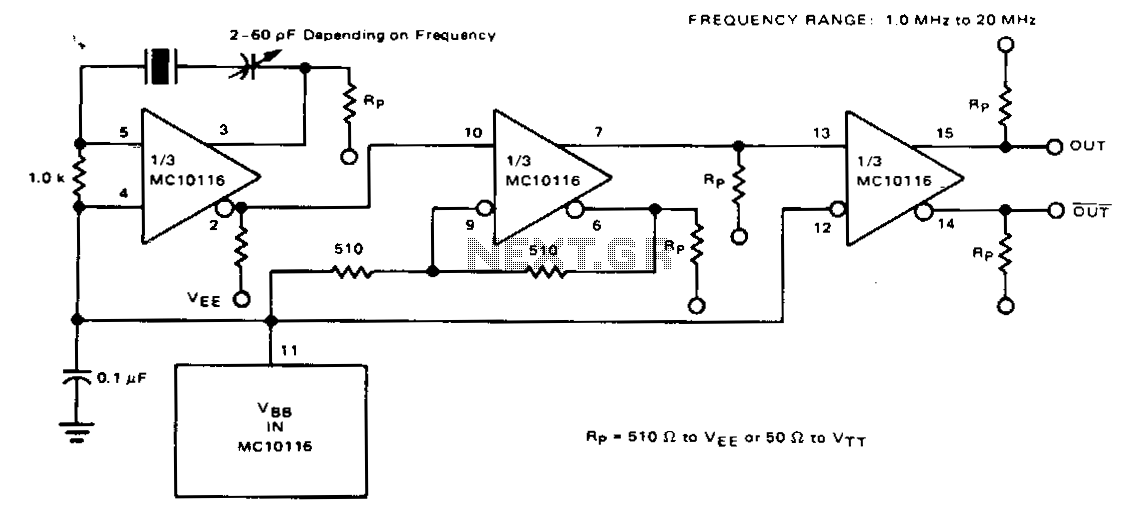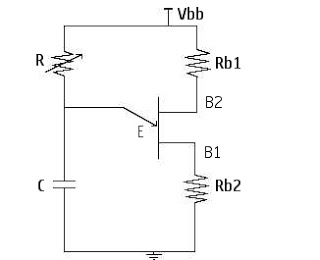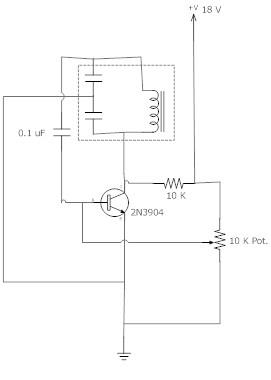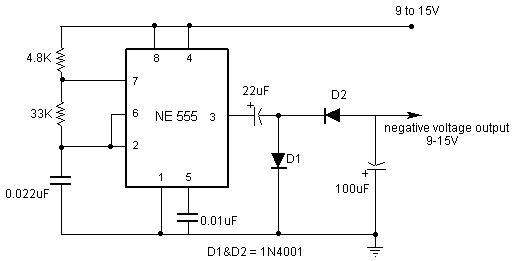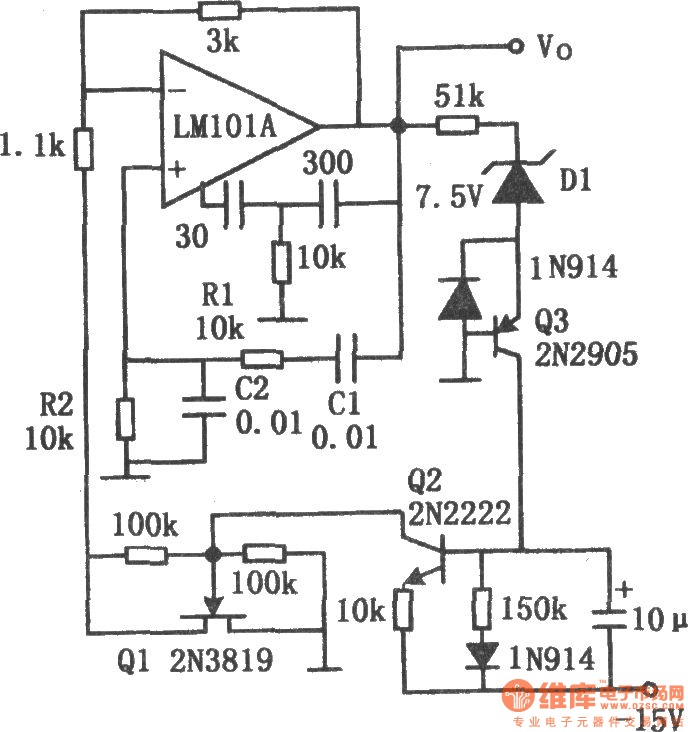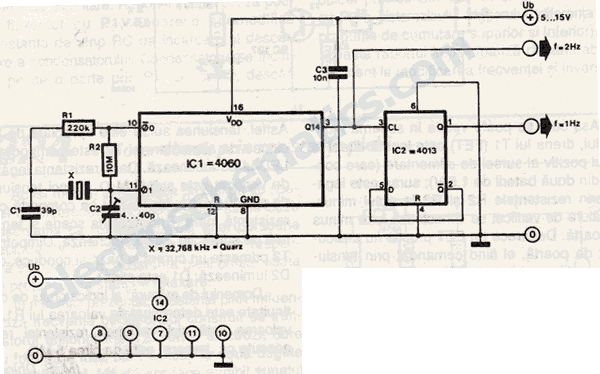
Operation of an Armstrong Oscillator
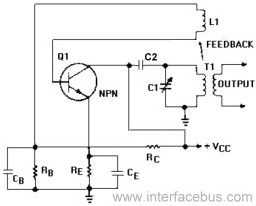
An Armstrong Oscillator is a type of oscillator that utilizes a tickler coil to provide feedback from the tank circuit. This oscillator generates a sine-wave output with constant amplitude and fairly constant frequency within the RF range. Inductor L1 functions as the tickler coil, delivering feedback from the output circuit (collector) to the input circuit (base) of the transistor. Inductor L1 is magnetically coupled to transformer T1, creating mutual inductive coupling between the tickler and the LC tuned circuit. The feedback in this oscillator circuit is regenerative. The transistor used is an NPN type, which can be any suitable NPN transistor. The circuit employs a basic common emitter configuration, and the specific transistor part number will depend on the frequency of operation and the value of the voltage used as Vcc. The key requirement is that the transistor must provide amplification within the frequency range of oscillation. A 2N2222 NPN transistor, for example, can operate up to 300 MHz. Resistor Rc biases the collector of the transistor, incurring a small loss over inductor L1 while applying Vcc to the collector circuit. Resistor Rb serves as the base bias resistor, and resistor Re acts as the emitter bias resistor, also known as self-bias. Capacitors Cb and Ce bypass the bias resistors for non-DC voltages, ensuring that the resistors only set the DC bias while shunting out AC voltages. The circuit depicted is a series-fed Armstrong oscillator where the tank circuit is formed by variable capacitor C1 and the primary of T1. DC voltage is applied to the tank circuit, making it a series-fed oscillator. Vcc is applied to the bottom side of the tuned circuit and returned via T1, the collector of Q1, and emitter resistor Re back to Vcc. The tank circuit is the frequency-determining component of the oscillator. The oscillation frequency is defined by the resonant frequency (Fr), calculated as 1 / (2 x π x √(LC)). Trimmer capacitor C1 allows frequency adjustments by varying the capacitance in the tuned circuit. The shunt-fed Armstrong oscillator, which differs slightly, does not apply DC voltage to the tank circuit. Vcc connects to resistor RC and bypasses the tank circuit directly to the collector of the transistor. In this configuration, only AC flows into the tank circuit, with capacitor C2 blocking any DC voltage. The tank circuit is grounded to provide a return path for the output of the transistor. An oscillator featuring frequency-determining components in the base of the transistor circuit uses a tickler coil for feedback from the tuned circuit. Resistor R1 regulates the current through L1; a higher resistance value increases feedback into the C1, L2 tank circuit. Trimmer R1 adjusts the current through L1 to sustain oscillations in the tank circuit, thereby controlling the gain of the feedback signal. Resistor R2 sets the DC bias voltage at the base of the transistor. With power applied, a small base current (Vcc/R2) flows through R2 to forward bias the transistor's base, while coupling capacitor C2 blocks any DC voltage from reaching the tuned circuit. As C2 is a blocking capacitor, this configuration is identified as a shunt-fed oscillator. The DC bias to the collector is established by the parallel combination of R1 and L1, noting that L1 is not part of the tuned circuit, so the DC current through L1 does not affect the oscillation directly.
The Armstrong Oscillator operates on the principle of regenerative feedback, making it a robust choice for generating RF signals. The design includes essential components such as inductors, capacitors, and resistors, each playing a critical role in the oscillator's functionality. The tickler coil (L1) is vital for providing the necessary feedback to maintain oscillations, while the variable capacitor (C1) allows for fine-tuning of the output frequency. The choice of NPN transistor impacts the overall performance, especially in high-frequency applications. Proper biasing through resistors (Rc, Rb, Re) ensures that the transistor operates efficiently within its active region, enabling effective amplification of the oscillation signal. The configuration of the circuit—whether series-fed or shunt-fed—determines how DC and AC voltages interact within the oscillator, influencing the overall performance and stability of the output signal. The careful selection and arrangement of these components are crucial for achieving desired oscillation characteristics, making the Armstrong Oscillator a fundamental design in RF applications.An Armstrong Oscillator is a type of oscillator that uses a tickler coil which provides feedback from tank circuit. The Armstrong Oscillator is used to produce a sine-wave output of constant amplitude and of fairly constant frequency within the rf range.
Inductor L1 operates as a tickler coil, providing feedback from the output circuit [collector] to the input circuit [base] of the transistor. Inductor L1 is coupled to transformer T1, by mutual inductive coupling. between the tickler and LC tuned circuit. For the circuit to oscillator, the feedback is regenerative. The transistor is identified as a NPN transistor, and could be almost any NPN transistor. The circuit is a basic common emitter configuration. The exact transistor part number would depend on the frequency of operation of the oscillator, and the value of the voltage used as Vcc. The important criteria is that the transistor provides amplification in the frequency range of oscillation.
A 2N2222 NPN Transistor offers operation up to 300MHz. Resistor Rc is used to bias the collector of the transistor, a small loss is incurred over inductor L1, applying Vcc to the collector circuit. Resistor Rb is the base bias resistor. Resistor Re is the emitter bias resistor, also called self-bias. The capacitors Cb and Ce are used to by-pass the bias resistors for non-DC voltages. The resistors only set the DC bias, for AC voltages the resistors are shunted out of the circuit. The circuit to the right shows a series-fed armstrong oscillator. The tank circuit is form by variable capacitor C1 and the primary of T1. DC voltage is applied to the tank circuit, making the circuit a series-fed oscillator. Vcc is applied to the bottom side of the tuned circuit and is returned via T1, the collector of Q1 and emitter resistor Re [than back to Vcc].
The tank circuit is the frequency determining component of the oscillator. The frequency of oscillation is determined by the resonant frequency [Fr] which is 1 / (2 x 2. 1415927 x [LC]1/2). Trimmer capacitor C1 provides adjustments to the frequency by varying the capacitance in the tuned circuit. See Trimmer Capacitors Styles, The shunt-fed armstrong oscillator [shown in the lower side-bar] differs slightly, in that the DC voltage is no longer applied to the tank circuit.
Vcc is still connected to resistor RC, but bypasses the tank circuit and connected directly to the collector of the transistor. In addition, only AC flows into the tank circuit, capacitor C2 blocks any DC voltage from the tank circuit.
The tank circuit is now grounded to provide a return path for the output of the transistor. An oscillator that has the frequency determining components in the base of the transistor circuit, and that uses a tickler coil which provides feedback from the tuned circuit. Resistor R1 sets the amount of current through L1, the higher the adjusted value of R1 the more current flows through the L1 winding.
So the higher R1 becomes the more feedback is presented or coupled into the C1, L2 tank circuit. Trimmer R1 is adjusted so that current through L1 is sufficient to sustain oscillations in the tank circuit. In other words the resistor adjusts the gain of the feedback, the higher the resistance value the higher the amplitude of the feedback signal.
Also refer to Companies producing Trimmer Resistors. Or Common Resistor Trimmer packages in common usage. Resistor R2 sets the DC bias voltage at the base of the transistor. With power applied a small amount of base current [Vcc/R2] will flow through R2 and forward bias the base of the transistor. While the coupling capacitor C2 blocks any DC voltage from reaching the tuned circuit. Because C2 is used as a blocking capacitor, this style of circuit is a shunt-fed oscillator. The DC bias to the collector is set by the parallel combination of R1 and L1. Note that L1 is not part of the tuned circuit, so the DC current flowing through L1 does not make the
🔗 External reference
The Armstrong Oscillator operates on the principle of regenerative feedback, making it a robust choice for generating RF signals. The design includes essential components such as inductors, capacitors, and resistors, each playing a critical role in the oscillator's functionality. The tickler coil (L1) is vital for providing the necessary feedback to maintain oscillations, while the variable capacitor (C1) allows for fine-tuning of the output frequency. The choice of NPN transistor impacts the overall performance, especially in high-frequency applications. Proper biasing through resistors (Rc, Rb, Re) ensures that the transistor operates efficiently within its active region, enabling effective amplification of the oscillation signal. The configuration of the circuit—whether series-fed or shunt-fed—determines how DC and AC voltages interact within the oscillator, influencing the overall performance and stability of the output signal. The careful selection and arrangement of these components are crucial for achieving desired oscillation characteristics, making the Armstrong Oscillator a fundamental design in RF applications.An Armstrong Oscillator is a type of oscillator that uses a tickler coil which provides feedback from tank circuit. The Armstrong Oscillator is used to produce a sine-wave output of constant amplitude and of fairly constant frequency within the rf range.
Inductor L1 operates as a tickler coil, providing feedback from the output circuit [collector] to the input circuit [base] of the transistor. Inductor L1 is coupled to transformer T1, by mutual inductive coupling. between the tickler and LC tuned circuit. For the circuit to oscillator, the feedback is regenerative. The transistor is identified as a NPN transistor, and could be almost any NPN transistor. The circuit is a basic common emitter configuration. The exact transistor part number would depend on the frequency of operation of the oscillator, and the value of the voltage used as Vcc. The important criteria is that the transistor provides amplification in the frequency range of oscillation.
A 2N2222 NPN Transistor offers operation up to 300MHz. Resistor Rc is used to bias the collector of the transistor, a small loss is incurred over inductor L1, applying Vcc to the collector circuit. Resistor Rb is the base bias resistor. Resistor Re is the emitter bias resistor, also called self-bias. The capacitors Cb and Ce are used to by-pass the bias resistors for non-DC voltages. The resistors only set the DC bias, for AC voltages the resistors are shunted out of the circuit. The circuit to the right shows a series-fed armstrong oscillator. The tank circuit is form by variable capacitor C1 and the primary of T1. DC voltage is applied to the tank circuit, making the circuit a series-fed oscillator. Vcc is applied to the bottom side of the tuned circuit and is returned via T1, the collector of Q1 and emitter resistor Re [than back to Vcc].
The tank circuit is the frequency determining component of the oscillator. The frequency of oscillation is determined by the resonant frequency [Fr] which is 1 / (2 x 2. 1415927 x [LC]1/2). Trimmer capacitor C1 provides adjustments to the frequency by varying the capacitance in the tuned circuit. See Trimmer Capacitors Styles, The shunt-fed armstrong oscillator [shown in the lower side-bar] differs slightly, in that the DC voltage is no longer applied to the tank circuit.
Vcc is still connected to resistor RC, but bypasses the tank circuit and connected directly to the collector of the transistor. In addition, only AC flows into the tank circuit, capacitor C2 blocks any DC voltage from the tank circuit.
The tank circuit is now grounded to provide a return path for the output of the transistor. An oscillator that has the frequency determining components in the base of the transistor circuit, and that uses a tickler coil which provides feedback from the tuned circuit. Resistor R1 sets the amount of current through L1, the higher the adjusted value of R1 the more current flows through the L1 winding.
So the higher R1 becomes the more feedback is presented or coupled into the C1, L2 tank circuit. Trimmer R1 is adjusted so that current through L1 is sufficient to sustain oscillations in the tank circuit. In other words the resistor adjusts the gain of the feedback, the higher the resistance value the higher the amplitude of the feedback signal.
Also refer to Companies producing Trimmer Resistors. Or Common Resistor Trimmer packages in common usage. Resistor R2 sets the DC bias voltage at the base of the transistor. With power applied a small amount of base current [Vcc/R2] will flow through R2 and forward bias the base of the transistor. While the coupling capacitor C2 blocks any DC voltage from reaching the tuned circuit. Because C2 is used as a blocking capacitor, this style of circuit is a shunt-fed oscillator. The DC bias to the collector is set by the parallel combination of R1 and L1. Note that L1 is not part of the tuned circuit, so the DC current flowing through L1 does not make the
🔗 External reference
